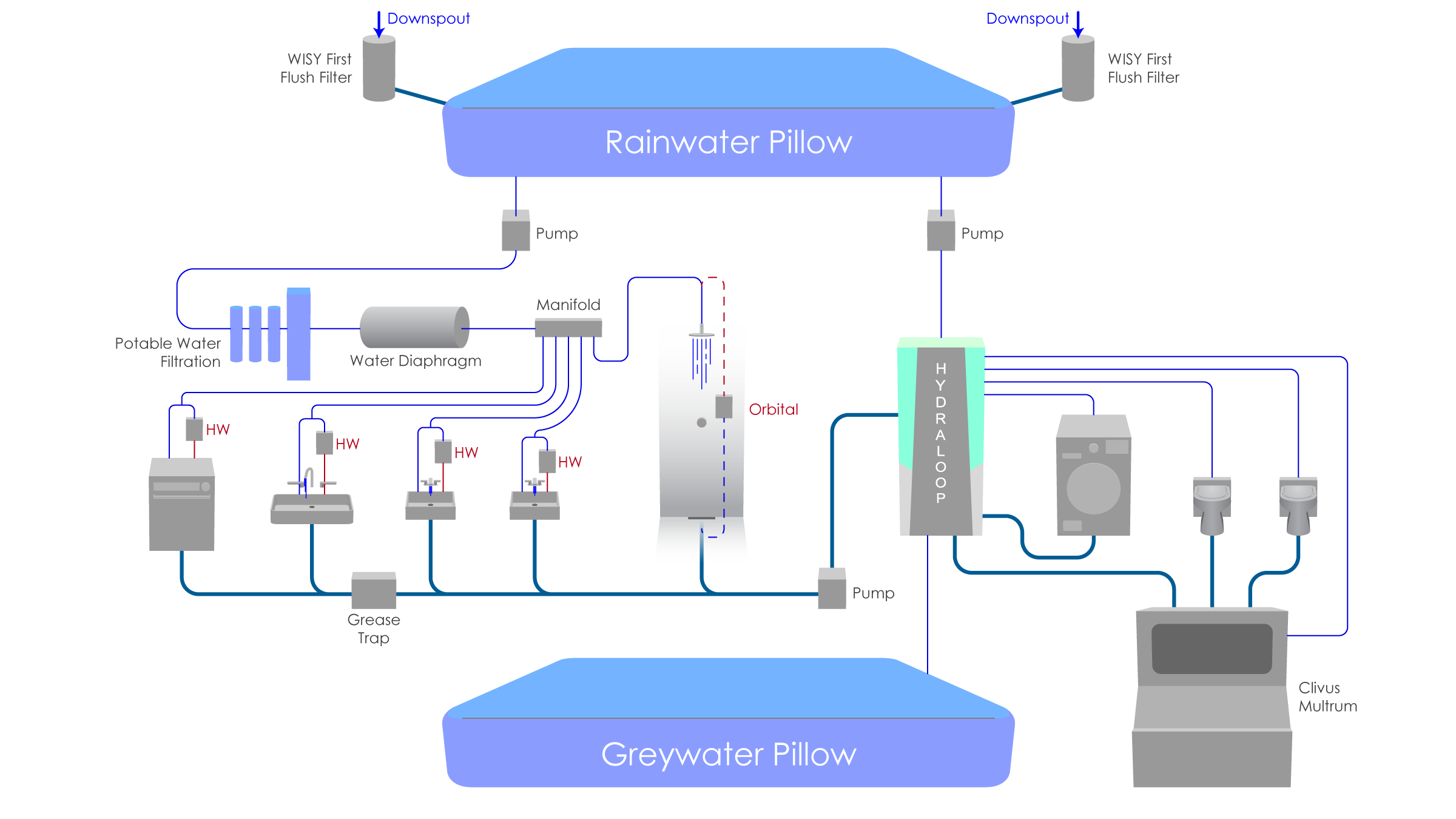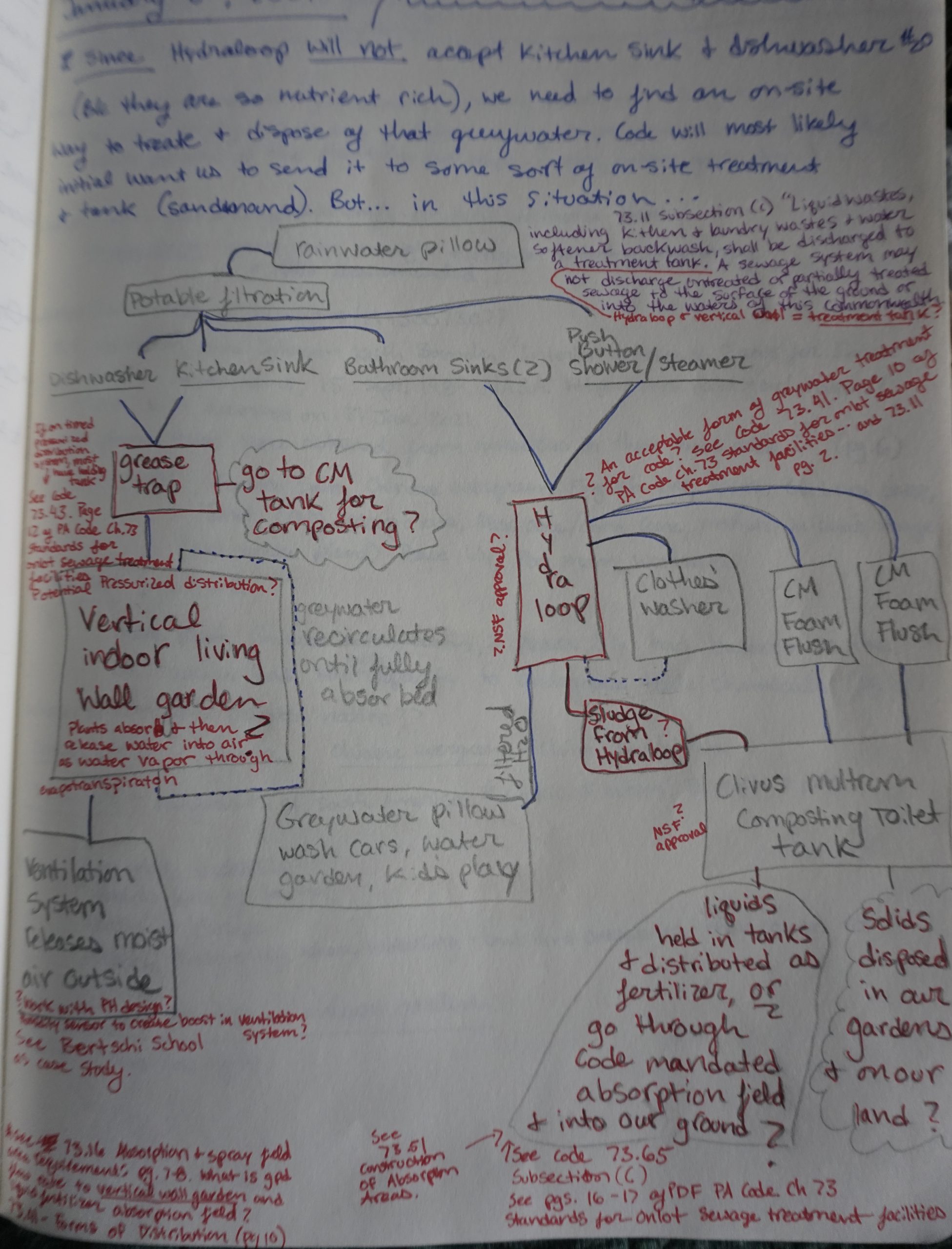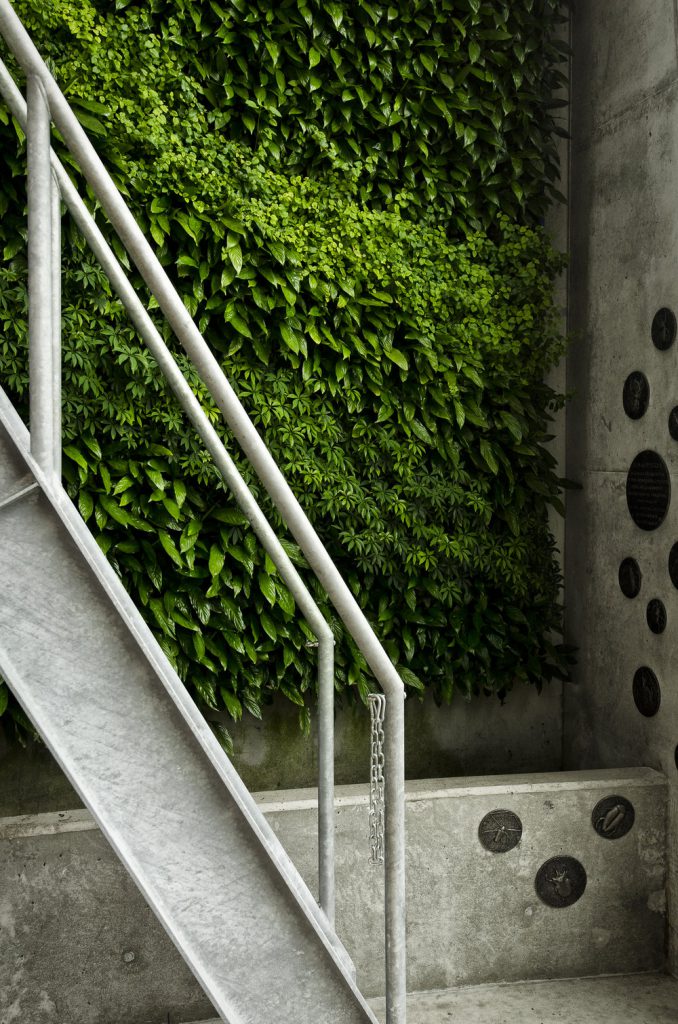Greywater Garden Staircase Railings? Solving the On-Site Wastewater Management Problem
Dear Readers,
So, if you glanced over last week’s blog, then you know that our hope, only a little less than a week ago, was this:

Our previous plan to managing our wastewater on-site…
Inspired to get our on-site wastewater management plan approved by code, I went ahead and delved into Title 25 of Pennsylvania’s Environmental Protection Code~ Chapter 73, standards for onlot sewage treatment facilities. Three cups of coffee and a couple chocolate bars later, I was still convinced that the above hope could still (just maybe) meet code… provided some things could qualify as other things…and some things would accept those things…loads o’ things.
Anywho, then we learned, yesterday, that a really big thing would not accept some other big things…changing our plans.
What we learned was that the Hydraloop system is not able to accept the greywater from our kitchen sink and dishwasher. Which leads us from William’s nicely illustrated drawing and beautiful plan…to my haphazard sketch…but still a beautiful plan if I do say so myself.1
Ha, our current plan to managing our wastewater on-site! Looking at this literatly makes me laugh out loud. So please don’t feel bad if you do as well…
Let me attempt to briefly explain our new plan of action in getting our on-site wastewater management system approved by code….
Essentially, from my understanding, it all comes down to 73.11, subsection C: “Liquid wastes, including kitchen and laundry wastes…shall be discharged to a treatment tank. A sewage system may not discharge untreated or partially treated sewage to the surface of the ground or into the waters of this commonwealth.”2 3
So, our question then becomes, will our Hydraloop (which would treat the greywater from our two bathroom sinks, shower/sauna, and clothes’ washer) and our indoor living wall greywater garden (which would treat our greywater from the kitchen sink and dishwasher) be considered by code as treatment tanks?
NOTE: There is also the bit about the liquid fertilizer coming from our Clivus Multrum composting tank, and whether we can distribute it as fertilizer directly on our gardens as Clivus Multrum suggests…or if we need to create an absorption field and drain the liquid fertilizer into our ground according to code 73.65 subsection C….but that’s for another time.4 Let’s talk about this indoor living wall greywater garden, shall we?
I am absolutely in love with the idea of an indoor greywater garden, and am actually kinda glad that Hydraloop will not accept the water from our kitchen…because I really, really, want this garden. The Bertschi School’s greywater wall is the source of inspiration for this lovely idea.
The Bertschi School’s Greywater Garden Wall~ Bertschi Living Building Science Wing — Green Roofs for Healthy Cities
However, because we lack space, instead of using a ‘wall,’ we are going to use our staircase railings to the loft. To give a rough idea on how I envision this working, here is an incredibly scribbled sketch that I made during lunch one day:
Scribbled sketch of greywater garden railings.
The plan is to have the water from the kitchen sink and the dishwasher drain through a grease trap. After some greasy nasties have been filtered out, the water will proceed to a kitchen specific greywater holding tank (NOT to be confused with our greywater pillow hooked up to the Hydraloop. These two greywaters must remain separate).
When little nifty sensors (…sensors, by the way, which we are not totally sure actually exist…)5 sense that the soil is dry-ish in the plant beds of our greywater staircase railings…it will send a signal to pump the water from the kitchen greywater holding tank,6 and through the pipe railings of the staircase.7 …Yes, our staircase handrails will also act as our greywater pipes. The magic of dual function!
The pipe railings will have holes in them, allowing the kitchen greywater to trickle to the first ‘tier’ of plants.
NOTE: Depending upon the gallons per day of water that goes down the kitchen drains, will determine the amount of tiers we need of plants. In code, the amount of gallons per day of water that goes down the drain determines how big your absorption field needs to be.8 Considering that we want this greywater garden to be our ‘treatment tank’ and ‘absorption field,’ we need to determine the amount of kitchen water we may use as a family of five per day.
Anywho, the water dripping from our pipe handrails will drip from one tier, and then filter down to the next, and then to the next…until it is at the bottom. If there is water left at the bottom, it will be pumped back up to the top, and filtered through again until all of the water has been sucked up by the plants. Once the water is absorbed, the plants will release the water into the air as water vapor through a process called evapotranspiration. Our ventilation system, which we intend to have a robust one in our Passive House design, will release the moist air out of the house.
Now, a key element to making this fancy vertical greywater garden staircase thing work, are the plants. We need plants that thrive off of super nutrient rich soil…which ours will be after all of that kitchen water. We also need plants that do well with indirect sunlight, and who are water-hungry. If anyone has any recommendations on what to grow, they would be most welcome!
For now, in a brief research session, I found that rhubarb, elderberry and blackberry bushes love greywater~ Irrigating fruit yielding plants with greywater are also safe to harvest from, as long as the greywater does not touch the edible portion of the plant (so, no carrots).9 As prickly, messy, and inconvenient an indoor blackberry bush sounds, I couldn’t help wondering how that would work…so I found some plants that do well with blackberry bushes: mint, chives, and hyssop.10
While I understand I should be more practical about the greywater-loving plants I plan to plant in our stair rail garden…I am tempted to try cultivating blackberries, mint, wild chives, and hyssop indoors in the spring…and drenching them with kitchen greywater to see what happens.
If anyone wants to talk me out of it with some more practical greywater indoor gardening ideas…I’m sure William would appreciate it.
Alright, that’s the rundown for now. I may go read some more PA code…especially since my blackberry bushes may not work…
Shelby Aldrich
P.S. I may start calling these editions of blogs, ‘spaz blogs.’ In essence, I learn a lot of things, and William and I come up with a lot of ideas, and then I feel the urge to throw it out there for my own reference to reflect back on…as well as some sort of self-justification to everyone else that we are still progressing with this crazy house. So, yes. Spaz blogs.
P.P.S. Found the people who built the Bertschi School’s greywater garden wall~ GSky. They not only built, but (I believe…) also helped pick plants best suited for their greywater filtration needs. We may consult them for help…instead of relying on my blackberry bush enthusiasms and experiments.
1. NOTE: If anyone, anywhere, has any ideas on how to make this work, please…please…comment below or send us an email! Even if you are in a different state…or country…and obviously don’t have to build to PA code…your ideas are still more than welcome.
2. Commonwealth of Pennsylvania. “Title 25- Environmental Protection. Chapter 73- Standards for Onlot Sewage Treatment Facilities, General Site Location and Absorption Area Requirements, 73.11.” 31 Oct. 2020. www.pacodeandbulletin.gov/Display/pacode?file=/secure/pacode/data/025/chapter73/s73.11.html&d=reduce. Accessed on 1 February 2021.
3. This, by the way, is why we were told that PA code cannot accept Clivus Multrum’s system of treating greywater…where the greywater was sent, untreated, out of the house and into the ground to a greywater garden which would then do the job of filtration.
4. “Chapter 73- Standards for Onlot Sewage Treatment Facilities, Recycling Toilet, incinerating toilet or composting toilet, 73.65.” 31 Oct. 2020. www.pacodeandbulletin.gov/Display/pacode?file=/secure/pacode/data/025/chapter73/s73.65.html&d=reduce. Accessed on 1 February 2021.
5. The Bertschi School does have sensors installed in their walls to determine greywater levels. GSky Green Wall at Bertschi School – Seattle, WA | GSky Living Green Walls
6. The Bertschi School had their water go through a preliminary filter (Aqua2Use filtration units) before going to the wall.
7. Not sure if this would be considered “pressurized distribution” by code? The Bertschi School used a red-list compliant drip irrigation system for theirs. “Chapter 73- Standards for Onlot Sewage Treatment Facilities, Dosing and Distribution Requirements, 73.43.” www.pacodeandbulletin.gov/Display/pacode?file=/secure/pacode/data/025/chapter73/s73.43.html&d=reduce. Accessed on 1 February 2021.
8. “Chapter 73- Standards for Onlot Sewage Treatment Facilities, General Site Location and Absorption Area Requirements, 73.16.” 31 Oct. 2020. www.pacodeandbulletin.gov/Display/pacode?file=/secure/pacode/data/025/chapter73/s73.16.html&d=reduce. Accessed on 1 February 2021.
9. Greywater Action. “Irrigating Plants with Greywater.” https://greywateraction.org/greywater-choosing-plants-and-irrigating/#:~:text=Other%20plants%20Other%20perennials%20that%20thrive%20on%20greywater,choose%20pH%20neutral%20soaps%20or%20use%20acidic%20mulch. Accessed on 1 February 2021.
10. Vanorio, Ame. “Growing Blackberries: A Complete Guide on How to Plant, Grow, & Harvest Blackberries.” Morning Chores. https://morningchores.com/growing-blackberries/#:~:text=Problems%20and%20Solutions%20to%20Growing%20Blackberries.%201%20Crown,blackberries%20with%20bird%20netting.%205%20Anthracnose.%20More%20items. Accessed on 1 February 2021.
2 Comments
Submit a Comment
© 2020 Sustaining Tree
© 2020 Sustaining Tree




What happens when there is a week of 10degree weather? That railing will be mighty cold!
Hey Granann! Luckily, our greywater garden will be indoors, and in a Passive House no less! So keeping it warm will not be a problem.
The railings themselves, however, are not actually going to work out. You will read about that in our next update…but, in essence, Gsky does some fabulous work with indoor vertical wall gardens, and they stated that a stair railing will not be able to hold the weight of their systems. So! We are finding space in our home for an actual full-out vertical greywater garden wall. The REAL challenge is finding a filtration system that is willing to handle kitchen sink and dishwasher water before we can use that water to irrigate our wall…you will probably read more about that in the next update as well 🙂 Thank you for reading!!!! <3